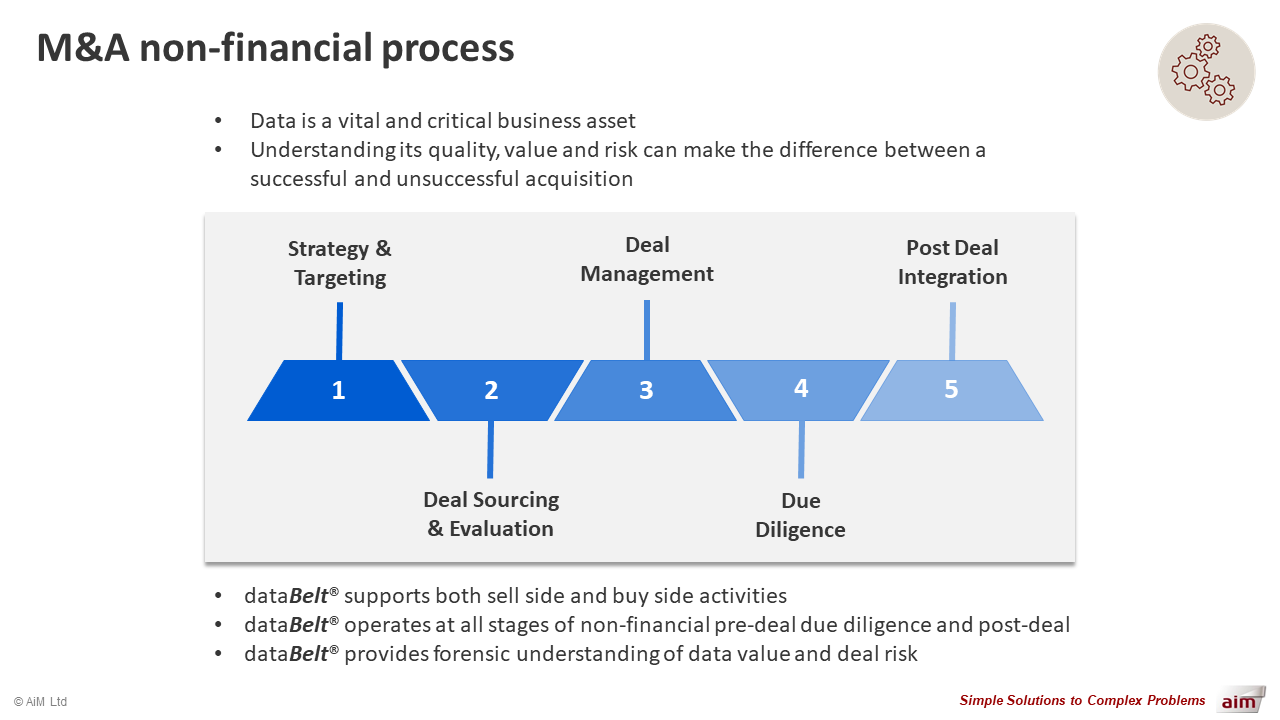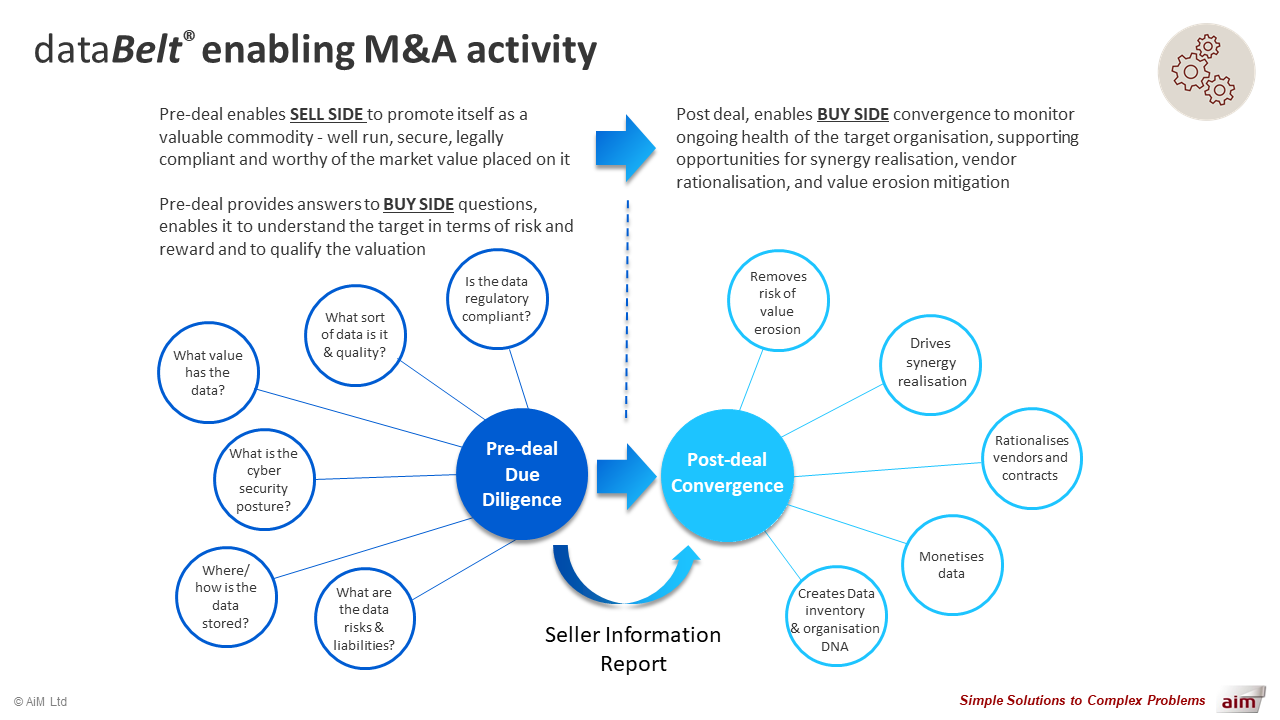The M&A due diligence route follows a well-trodden path in terms of discovering a target’s assets, its financial situation, sales pipeline, to name a few. What’s so often missing from this picture is an understanding of the target’s data – what data they have, where and how it is stored, how secure it is, its risks, liabilities and of course, its value. In addition, how data can create a blueprint of the organisation and assist with post-deal analysis to assist with integration.
The discovery and drill down of a target’s data is crucial information to the buy side, but the sell side too can capitalise on the knowledge it gains from this exercise. Understanding its own data position means maximising the sale price and minimising any possibility of post-deal problems.
In one of its key use cases, dataBelt can be leveraged by both the buy side and sell side during mergers, acquisitions and divestments, and also, post deal, and is used by organisations, M&A consultants and private equity investors.

A non-financial due diligence
At the core of dataBelt’s application within the M&A lifecycle is the concept that data is a vital and critical business asset.
Therefore, in order to complete a successful acquisition, we need to understand the quality, value and risk of our data. dataBelt discovers, indexes and classifies data in all forms from all structured and un-structured sources.
To put this in context: if I want to understand the scope and current liabilities in a sales target from all its vendor contracts, quickly and efficiently, rather than manually searching for and reading through all of them, dataBelt will discover and transcribe all of their contents so that the key elements contained in each contract - such as vendor, scope, duration, cost - can be presented in a fraction of the time possible through manual means, and at a fraction of the cost.
Imagine now that dataBelt is used across an organisation’s entire data estate and you can start to imagine the power that dataBelt has in the M&A context.
dataBelt platform overview
dataBelt achieves this using an AI enabled, robotic data crawler which indexes data across an organisation’s entire data estate.
Using TensorFlow machine learning, data is classified intelligently, using business rules to auto-define what category of data it is. If dataBelt finds any document, for example, an invoice, it uses Optical Character Reading (OCR) to KNOW it’s an invoice of a specific type, that relates to a specific product, that relates to a specific vendor. dataBelt indexing also allows high data volumes to be forensically interrogated at the field, text string, image and audio level. If we need to locate a call recording that contains a word or phrase, dataBelt will pull it back from the index it has created in seconds.
dataBelt is also built on powerful APIs, which allow secure integration with any and all systems and data sources. And as an analytical tool, it integrates fully with any M&A platform/data room that is used to plan and run an M&A project.
Thus, all the analysis and insightful data captured by dataBelt can update your planning system.
dataBelt enabling M&A activity

Pre-deal
Pre-deal, dataBelt allows both buy side and sell side to answer questions such as “Is the data the target acquisition holds regulatory compliant?”, “What are the data risks & liabilities?” “How secure is the data?” and “How valuable is the data?”.
The rich data insight that dataBelt provides enables the sell side to promote itself as a valuable commodity, worthy of the market value placed on it. And it provides the buy side with answers it needs to key questions around risk and reward in order to qualify the valuation.
dataBelt can be used by both buy side and sell side, and in addition by the sell side at an early pre-deal stage to get itself into good shape by using dataBelt to undertake health-checks of its organisation, and/or to maximise that all important value multiplier.
dataBelt can then assemble and collate the answers to these questions into a Seller Information Pack, which can be provided by the seller in hard copy or shared with the prospective buyer through dataBelt’s secure online portal.
Post-deal
Post deal and with ongoing use of dataBelt, the platform enables the next phase of M&A activity during the warranty period and after, that is continuing to validate the acquisition, checking that no suspicious actions are taking place prior to the seller disengaging, monitoring the ongoing health of the acquisition, as well as supporting key actions such as operational synergy rationalisation and analysing strategic acquisition information.
All the insight that supported the buy and sell sides throughout the pre-deal due diligence continues to enhance the analytical capability of the acquired organisation, removing the risk of value erosion and supporting subsequent M&A convergence activity.
Benefits of using dataBelt
- The buy side can gain an understanding of regulatory and security compliance, reduce post-deal risks and liabilities, gain an understanding of organisational data ‘DNA’ – that is how the selling organisation works and the data flows it controls - and understand the true value of data assets.
- The sell side can maximise its value, facilitate efficient deal management, minimise the impact and cost of manual due diligence, as well as reducing the risk of post-deal litigation during the post deal warranty period.
- dataBelt can also deliver document management and identify suspicious document/data behaviour – for example large data downloads, data moved to insecure locations or jurisdictions – which may point to data being stolen or compromised. In short, dataBelt provides full transparency for all parties, qualifying the valuation in full and reducing risk.
dataBelt provides exciting new insight for M&A activity. In addition though, dataBelt is a complete data solution covering all aspects of data discovery, visualisation, cleansing and transformation. Take a look at our other videos in this series to see other the diverse use cases across all sectors that the dataBelt platform supports.

